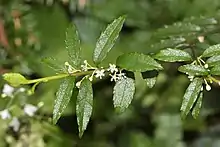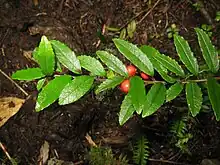| Ilex rugosa | |
|---|---|
 | |
| Cruciform flowers are inconspicuous. | |
 | |
| Fruit are large for a holly.[1] | |
| Scientific classification | |
| Kingdom: | Plantae |
| Clade: | Tracheophytes |
| Clade: | Angiosperms |
| Clade: | Eudicots |
| Clade: | Asterids |
| Order: | Aquifoliales |
| Family: | Aquifoliaceae |
| Genus: | Ilex |
| Species: | I. rugosa |
| Binomial name | |
| Ilex rugosa | |
| Synonyms[2] | |
| |
Ilex rugosa, the tsuru holly, is a species of flowering plant in the family Aquifoliaceae, native to southern Khabarovsk Krai, Sakhalin, and the Kuril Islands in Russia, and to eight mountain summits in Japan.[2][1] It is usually quite prostrate (growing ever lower with increasing altitude) and does well in areas with protective winter snow cover to prevent damage from late frosts.[1]
Because of its cold-hardiness, Kathleen Meserve crossed it with Ilex aquifolium (common holly) and produced hybrids dubbed the "blue hollies" and later given the scientific name Ilex × meserveae.[3] Two of these hybrid shrubs, sold as clones, have gained the Royal Horticultural Society's Award of Garden Merit.[3] 'Conapri' (trade name Blue Princess) is female.[4] 'Conablu' (trade name Blue Prince) is male and grows a bit taller than 'Conapri', perhaps 2 m (7 ft) at maturity.[5][3]
References
- 1 2 3 "Ilex rugosa - tsuru holly". mustila.fi. Arboretum Mustila. 2022. Retrieved 1 October 2022.
- 1 2 "Ilex rugosa F.Schmidt". Plants of the World Online. Royal Botanic Gardens, Kew. Retrieved 1 October 2022.
- 1 2 3 "Ilex rugosa Fr. Schmidt". Trees and Shrubs Online. International Dendrology Society. Retrieved 1 October 2022.
'Blue Angel'
- ↑ "Ilex × meserveae Blue Princess ('Conapri') (f) holly [Blue Princess]". The Royal Horticultural Society. 2022. Retrieved 1 October 2022.
- ↑ "Ilex × meserveae Blue Prince ('Conablu') (m) blue holly [Blue Prince]". The Royal Horticultural Society. 2022. Retrieved 1 October 2022.